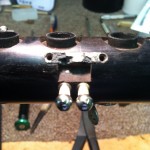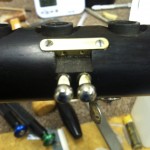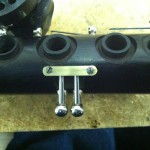When it comes to maintaining your oboe, there are a couple of things to consider and a couple terms we use at Onks Woodwind, adjustment and cleaning. Those of you that play oboe know there are a lot of adjustment screws on an oboe. These screws are used to change the relationship between different keys, which ultimately make the oboe play well, or not. Performing a basic adjustment on an oboe shouldn’t take very long, which is why I usually do not charge for that service. Wait, what? Basic adjustments are needed throughout the year to keep your oboe in playing condition, so find someone you can trust and become their friend. Who should be able to perform a basic adjustment? Most repair shops, even if they don’t specialize in oboe, should be able to perform a basic adjustment. If you are a professional oboist, you should be able to perform basic adjustments. If you are a college student with aspirations of becoming a professional oboist, you should be learning how to perform basic adjustments. I first started learning when I was a freshman in college from Mr. Sawicki’s oboe adjustment guide.
This is where it gets a little tricky. For an oboe to perform at its best, all pads must be level or covering the tone holes as perfectly as possible. If a pad is leaking there is no amount of “adjusting” that will make the oboe play better. Because of this, performing a basic adjustment, many times, will not do justice for the oboe. At Onks Woodwind we recommend that you have a yearly cleaning, especially if you are a professional player. During the course of a year of heavy oboe playing, pads compress and adjustment corks wear out. Standing moisture collects dust over time from the environment and from swabbing, tone holes must be cleaned. (See one of my previous posts for pictures.) Oil deteriorates and keys become sluggish, other things like bent keys, rust, loose posts and keys are always possible. These are just a few common things that happen over time to your oboe. For many professionals that record in studios, it is essential that the oboe mechanism be quiet and to achieve this, the mechanism must be serviced regularly. A full cleaning and set-up at Onks Woodwind includes a complete disassembly of the oboe. All tone holes are cleaned and octave vents re-sealed. All hinge tubes, rods and posts are cleaned with solvent to remove old oil, dust, dirt, and/or tarnish and corrosion. Tenons are checked for wobbling and tenon corks are replaced if necessary (note, if tenon wobble is severe, a larger tenon cork will not fix the problem. Other repair methods must be used.) During re-assembly, all pads are checked individually for levelness and replaced, if necessary, as well as all adjustment corks are checked and replaced, if necessary. After all pads are as level as possible, that is when all adjustments are made to the adjusting screws. Keeping an oboe in tip top shape requires more than an “adjustment”. If you have never had a full cleaning and set-up, you will be amazed at what you have been missing. Many clients make comments like, “It wasn’t my reeds!” “Now I can actually play with ease.” Playing oboe has enough challenges and variables that are not easily controlled, but you can control the maintenance of your instrument.
Onks Woodwind schedules all repairs! You will know when to ship your oboe, when the oboe will be repaired, and when your oboe will return to you. Contact us to change your oboe world.





